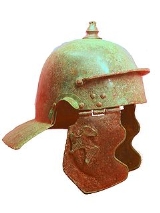
Cohors II Gallorum Dacica equitata
Encyclopedia
Cohors secunda Gallorum Dacica equitata ("2nd part-mounted Cohort of Gauls
in Dacia") was a Roman auxiliary regiment which contained both infantry and cavalry contingents.
It was probably originally raised in Gallia Lugdunensis
(northern France) during the rule of the founder-emperor, Augustus
(r. 30 BC - AD 14). The regiment is first attested in Dacia
(Romania) in 109, shortly after the end of the Dacian Wars (101-106) and thus probably participated in those wars. Its last datable attestation is from 179, still in Dacia Superior. Its later fate is unknown.
The regiment was previously known as II Gallorum Pannonica to distinguish it from another II Gallorum, which became known as cohors II Gallorum Macedonica, a purely infantry regiment. The title Dacica first appears in the record in 156.
The full name of just one praefectus (regimental commander) survives: Publius Licinius Maximus, from an undatable inscription on a dedicatory stone at Alhambra
in Spain, which may have been his home region. Also attested (144) is a Thracian
eques (ranker cavalryman), whose name is only partially preserved.
Gauls
The Gauls were a Celtic people living in Gaul, the region roughly corresponding to what is now France, Belgium, Switzerland and Northern Italy, from the Iron Age through the Roman period. They mostly spoke the Continental Celtic language called Gaulish....
in Dacia") was a Roman auxiliary regiment which contained both infantry and cavalry contingents.
It was probably originally raised in Gallia Lugdunensis
Gallia Lugdunensis
Gallia Lugdunensis was a province of the Roman Empire in what is now the modern country of France, part of the Celtic territory of Gaul. It is named after its capital Lugdunum , possibly Roman Europe's major city west of Italy, and a major imperial mint...
(northern France) during the rule of the founder-emperor, Augustus
Augustus
Augustus ;23 September 63 BC – 19 August AD 14) is considered the first emperor of the Roman Empire, which he ruled alone from 27 BC until his death in 14 AD.The dates of his rule are contemporary dates; Augustus lived under two calendars, the Roman Republican until 45 BC, and the Julian...
(r. 30 BC - AD 14). The regiment is first attested in Dacia
Dacia
In ancient geography, especially in Roman sources, Dacia was the land inhabited by the Dacians or Getae as they were known by the Greeks—the branch of the Thracians north of the Haemus range...
(Romania) in 109, shortly after the end of the Dacian Wars (101-106) and thus probably participated in those wars. Its last datable attestation is from 179, still in Dacia Superior. Its later fate is unknown.
The regiment was previously known as II Gallorum Pannonica to distinguish it from another II Gallorum, which became known as cohors II Gallorum Macedonica, a purely infantry regiment. The title Dacica first appears in the record in 156.
The full name of just one praefectus (regimental commander) survives: Publius Licinius Maximus, from an undatable inscription on a dedicatory stone at Alhambra
Alhambra, Ciudad Real
Alhambra, Ciudad Real is a municipality in Ciudad Real, Castile-La Mancha, Spain. It has a population of 1,213....
in Spain, which may have been his home region. Also attested (144) is a Thracian
Thracians
The ancient Thracians were a group of Indo-European tribes inhabiting areas including Thrace in Southeastern Europe. They spoke the Thracian language – a scarcely attested branch of the Indo-European language family...
eques (ranker cavalryman), whose name is only partially preserved.

